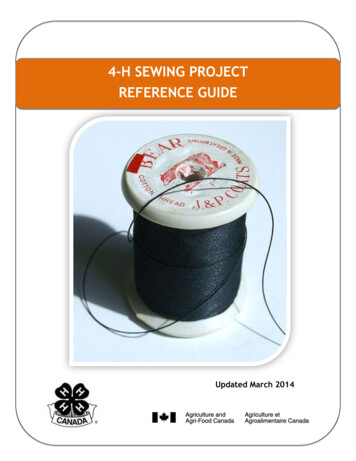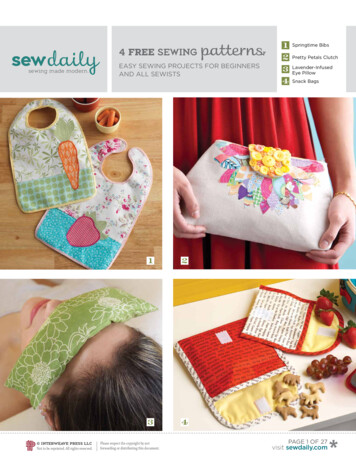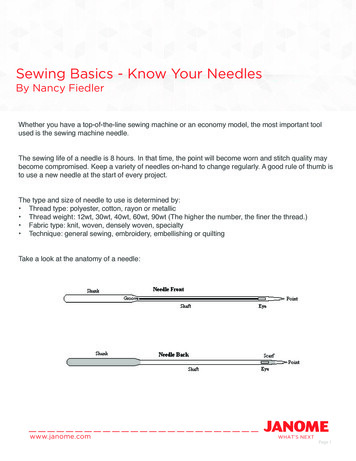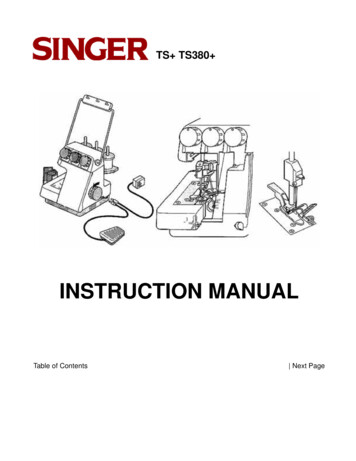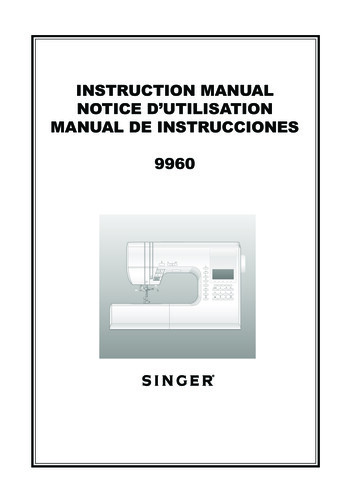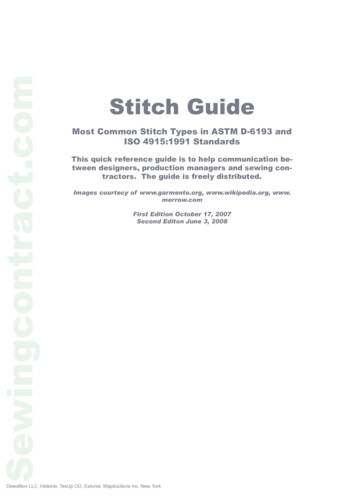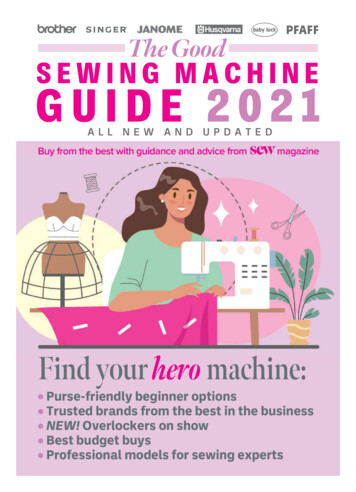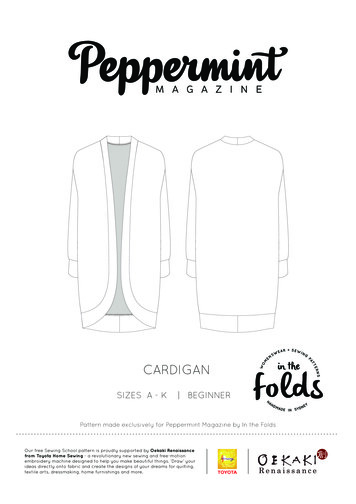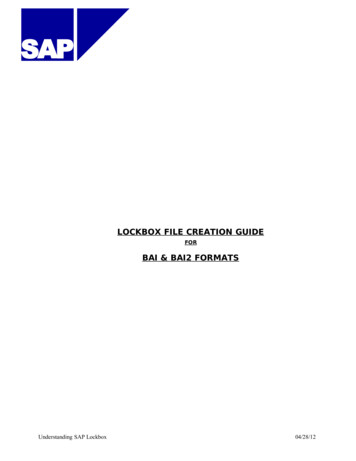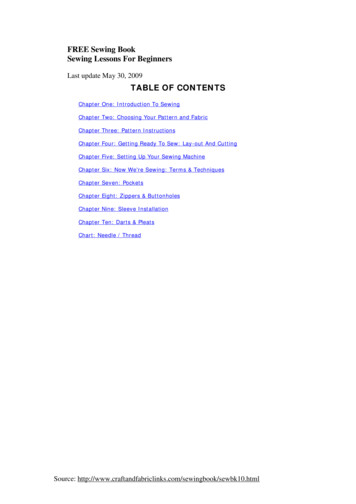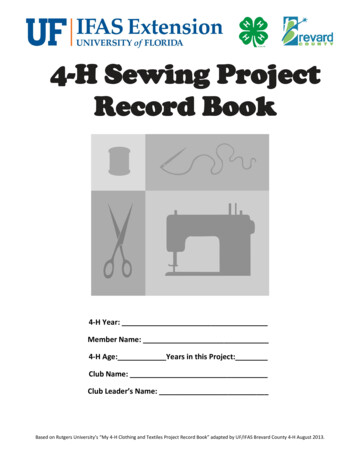
Transcription
4-H Sewing ProjectRecord Book4-H Year:Member Name:4-H Age: Years in this Project:Club Name:Club Leader’s Name:Based on Rutgers University’s “My 4-H Clothing and Textiles Project Record Book” adapted by UF/IFAS Brevard County 4-H August 2013.
My 4-H Sewing Project Record Bookp. 2SIGNATURESDuring the 4-H year your leader should review your book to see your progress and offersuggestions. At the end of the year all signatures should be completed and dated.Periodic Check SignaturesBy signing below, I am stating that I have reviewed this record book with the 4-H memberfor accuracy and completeness to date.Leader SignatureDateEnd of Year SignaturesBy signing below, I am stating that I have completed this record book myself and, to thebest of my knowledge, the information included in it is correct.Member SignatureDateBy signing below, I am stating that I am familiar with this work and, to the best of myknowledge, the member completed this record book, and the information included in it iscorrect.TitleParentClub LeaderSignatureDateThe Institute of Food and Agricultural Sciences (IFAS) is an Equal Opportunity Institution authorized to provide research,educational information and other services only to individuals and institutions that function with non-discrimination withrespect to race, creed, color, religion, age, disability, sex, sexual orientation, marital status, national origin, political opinions oraffiliations. U.S. Department of Agriculture, Cooperative Extension Service, University of Florida, IFAS, Florida A. & M.
My 4-H Sewing Project Record BookIntroductionWhat is a 4-H project?A project is a subject or topic that you learn about in 4-H. More importantly, a project issomething you do or make, which results from knowledge and skills you learned in theclothing and textile project. You learn about your project from attending club meetingsand educational workshops, and working with adult leaders and other 4-H members. Youcan also learn from field trips and camps, by participating in shows and competitions, aswell as through your family and self-study.Why complete a record book?A record book is not meant to be a chore. Instead, it is a way for you to learn. Here aresome important reasons why 4-H expects you to complete a 4-H record book for yourproject.Keeping a 4-H record book will help you . Learn how to organize yourself.Learn how to set reasonable goals for yourself.Appreciate what you’ve learned this year from the goals you reached.Recognize what things you’ve learned in your 4-H project.Explain what you’ve learned.Keep track of costs of your project.Gather information needed to apply for awards and scholarships.Complete applications and resumes for jobs and college.Meet requirements to participate in some county, state, or national 4-H events.Member in good standing requirementsIn general, all 4-H members are expected to meet the following standards each year.These are the minimum requirements. Your club may have additional requirements. Attend at least 70 percent of regular club meetings and/or activities.Complete a 4-H project record, doing one’s own work with minimalassistance from parents or others.Give a club or county 4-H public presentation.Complete a project record book (like this one).p. 3
My 4-H Sewing Project Record Bookp. 4Starting OutMy Project Goals For This 4-H YearThe beginning of the 4-H year is a good time to begin thinking about what you wouldlike to do or learn in 4-H during the upcoming months. List some of your goals for theyear and what plan you have to accomplish your goals. Talk to your leader andparents to decide what goals are realistic to try and possible to finish this year.During each year in the 4-H Sewing project area, members should choose a minimum of threegoals to pursue. Suggestions are listed in the Appendix on page 15. Write your choices below. Don’tbe afraid to challenge yourself! Of course, you may aim to reach more goals. For now, write yourgoals below and your plan for reaching each goal. If the items on the list have all been accomplished,develop some of your own.My goals for this yearWhat I need to do to reach this goalExample: I will learn how to give a publicpresentation.Attend county public presentationworkshop. Have my leader andparent help me pick a topic that will begood for me. Practice my presentation.Give the presentation at a clubmeeting.
p. 5My 4-H Sewing Project Record BookAlong the Way – Keeping track of what I doFor this section, it is best to write down what you have done shortly after completing it so youwon’t forget important events and activities. This section includes the following parts: What I did in this project yearOther 4-H activities and events I participated inProject financesOther clubs and projectsWhat I did in Sewing Project this yearWhat I did or made in my projectDateCompletedExample: Made a pin cushion out of cotton fabric3/1/13
My 4-H Sewing Project Record Bookp. 6Other 4-H activities and events I participated inBesides the clothing and textiles projects you completed, the following page is where you canlist what else you did in this project area. Don’t forget to include these types of activities youmight have done this year: Name ofEvent/ActivityField tripsShows and competitionsMeetingsLeadership roles- such as offices held, committees led, etc.Events participated inCommunity servicePublic speakingCounty 4-H FairDate & LocationExample: Attended a 2/1/13sewing workshopJoAnn Fabrics(Add other pages if necessary)What I didLevelClub, County, StateAward orRecognition EarnedParticipated inworkshop using aserger.ClubNone
My 4-H Sewing Project Record Bookp. 7Project FinancesIt is likely that you spent money on your 4-H project this year. This section will help you add upwhat it cost to complete your project.Expenses (E)This section is where you can keep track of what materials, supplies, and equipment youpurchased or used for your project and what it cost to use.Don’t forget: Cost of items purchased, including equipment and suppliesCost of maintenance or repairsEntry fees for any shows or exhibitionsDateDescription of ExpenseCost ( )3/1/13Example: Purchased Thread, 2 yards fabric @ 5.00/yard 12.50TotalExpenses(Add up all Expenses from above and put number in box atright)
p. 8My 4-H Sewing Project Record BookIncome (I)List any income received from your project this year. For example, sales of any project-relateditems or cash prizes from contests or exhibitions. It is quite likely your project had no income. Ifso, enter “NONE” under description and “0” under Total Income.DateDescription of IncomeIncome ( )5/1/13Example: Sold pillowcase at craft fairTotalIncome(Add up all income from above and put in number in box atright) 8.00Net Project Cost or Profit (N)If your project earned more than it cost, then your project made a profit. But this is not likely sodon’t worry if your project did not make money! Although a business aims to earn a profit, a 4-Hproject is meant for learning. The important point to learn is that most activities have costs.Therefore, you must be careful to spend money wisely.More likely, you spent more on your 4-H project than you earned from it.Therefore, “expenses” minus “income” is the total (or “net”) cost of yourproject.Total Expenses (E)Example: 12.50Minus Total Income (I) Net Project Cost (N) 8.00 4.50My actual numbers:
My 4-H Sewing Project Record Bookp. 9Project Completion PagePhoto or drawing of projectSample(s) of FabricPattern: Fabric:#yards @ per yard Thread: Zipper: Buttons: Miscellaneous: Total Cost: Project Cost:New skills I learned:Evaluation completed on RATING RECEIVED: (Circle one)ExcellentBlue qualityVery GoodRed qualityGoodWhite qualityAdd additional pages as necessary – one for each project
My 4-H Sewing Project Record BookOther clubs and projectsList any other clubs and projects you participated in during this past year.ClubProjectLooking Back – What I learned this yearThe next section is to be completed at the end of the 4-H year. It is meant to help you look backon all that you have learned during the past year. This section includes the following parts: My goals completedKnowledge and skills I gainedTelling my storyp. 10
My 4-H Sewing Project Record Bookp. 11My goals completedLook back on the goals you set for yourself at the beginning of the year. How well did you meetthose goals? If you added new goals during the year, add them and explain them below.My goals for this yearHow well did each goal get met?Example: I will learn how to give a publicpresentation.I attended the county public presentationworkshop. I practiced my presentation for my cluband ended up changing my title. I plan to pick atopic and get started earlier next year.
My 4-H Sewing Project Record Bookp. 12Knowledge and skills I gainedThere are many things to learn in 4-H. Check each item below that you have learned orimproved in 4-H during the past year.I learned or improved Personal SkillsWorking with other peopleTo set goals for myselfoHow to listen to other peopleHow to organize myselfoParliamentary procedureHow to finish something I startedoHow to lead othersHow to pay attention to instructionsoHow to solve problemsTo feel good about myselfoHow to run a business meetingKnowledge of my projectoHow to participate in a business meetingTo be proud of my accomplishmentsoHow to work with adultsTo make something with my handsoHow to give a public presentationTo follow directionsoTo feel comfortable speaking in front of aTo try something newgroupTo accept changeoHow to help others succeedHow to keep records of important information inoTo understand my strengths andmy projectweaknessesTo take responsibility for my own words andoTo make new friendsactionsoHow to get along with other kidsWhat is important to meoTo accept people who are different fromWhat I am interested inmeHow to get more information about something IoHow to work on a committeeam interested inoHow to work with a club to complete aHow to satisfy my curiosity about a new subjectcommunity service projectTo deal with winning and losing gracefullyoHow to give the 4-H PledgeHow to be careful and practice safetyoHow to work with other kidsTo explore a career interestoTo respect someone else’s feelingsHow to make wise choices and decisionsNew words and how to use themHow different things relate to each otherTo appreciate my cultural heritageTo keep track of financesoooooooooooooooooooooooooFeel free to add any other items not listed above in the space below.ooo
My 4-H Sewing Project Record BookTelling my 4-H storyKeeping in mind the knowledge and skills you saidyou learned from the items you listed above, write astory that explains what you have gained this pastyear in 4-H. Use specific examples that are uniqueto you whenever possible. Feel free to relate whatyou have learned in 4-H to school, family, or otheractivities in your life. Use extra pages if needed.Attach photos or clippings on additional pages ofthis book if it helps tell your story better. Don’tforget to label them with captions if you do.(Continue 4-H story on next page)p. 13
My 4-H Sewing Project Record Book(Continue 4-H story below or attach additional pages if necessary)p. 14
My 4-H Clothing and Textiles Record Bookp. 15AppendixThe Appendix contains the following parts: Sewing Knowledge and SkillsPersonal Development ActivitiesDuring each year, members may choose several knowledge and skill goals. Do notbe afraid to challenge yourself!Item #Sewing Skills for Beginners (1- 3 years in project)C-1Identify and use properly the following sewing tools:Scissors,shears, pinking shears, pins/pin cushion, thimble, needles –hand and machine, marking tools, seam ripperC-2Identify and demonstrate the following measuring tools: Ruler,tape measure, seam gauge, etc.C-3Name the parts of a sewing machineC-4Thread machine and insert/fill a bobbinC-5Change machine needleC-6Recognize balanced stitchingC-7Control the following elements of using a sewing machine: Speedand fabric running through machineC-8Be able to change the following when using a machine:Length ofstraight stitch, length & width of zigzag stitch, settings to stretchstitchingC-9Know proper uses of the following stitches: Straight, basting,zigzag and stretchC-10Use the seam guide on machine and pivotC-11Use good habits while sewing:Proper lighting, good posture,clean-up skillsC-12Recognize the difference between knit and woven fabricC-13Recognize the following fabrics:Solid, print, striped, plaid,lengthwise grain, crosswise grainC-14Choose appropriate fabric for patternC-15Match thread to fabricC-16Lay out and cut patternC-17Pre-treat fabric, press seams and complete a final press
My 4-H Clothing and Textiles Record Bookp. 16C-18Demonstrate sewing a straight seam, square corner, curved seamC-19Backstitch at ends of seamsC-20Trim seamsC-21Machine hemC-22Thread a needle, tie a knot and use a thimble when handstitchingC-23Use a variety of hand stitches – i.e.: Basting, blind, overhand andrunning.C-24Demonstrate sewing in care labelsC-25Replace buttons and repair broken seamsC-26Sort clothes for laundryC- 27Take body measurements to determine pattern size and typeC- 28Compare body measurements to pattern measurmentsC- 29Determine amount of fabric needed to construct an itemC- 30Use pattern pieces and markingsC- 31Lay out pattern on fabric using pattern guide. Pin and cut outgarmentC- 32Recognize differences between knit, woven, & non-woven fabricsC- 33Transfer pattern markings to fabric using a variety of methods.Example: Marking pens, pins, tailor’s chalk/tacks, tracing wheel& carbonC- 34Select correct pattern sizeC- 35Lay out pattern – “with nap”, “with out nap”C- 36Construct a shirt, vest, blouse or topC- 37Construct shorts, culottes/split skirtC-38Stitch with grain of fabricSewing Skills for Intermediates (4-6 years in project)C-39Recognize balanced tension on sewing machineC- 40Adjust upper tension/ presser foot pressureC- 41Recognize & use special stitches on your machineC- 42Use a zipper foot
My 4-H Clothing and Textiles Record Bookp. 17C- 43Change the light bulb/ clean and oil machineC- 44Using a serger be able to do the following: Recognize balancedtension, sew a seam, adjust tension, adjust stitch width & length.Change needles. Clean and oil machine.C- 45Recognize weaves- plain, satin, twillC- 46Determine notions and trim neededC- 47Differentiate between sewing with a knit & a wovenC- 48Pre-treat fabric & notionsC- 49Fit by making minor pattern adjustmentsC- 50Use a variety of interfacings- non-fusible, fusibleC- 51Machine basteC- 52Use different seam constructions – plain, flat felled, French,stretch stitchC- 53Use different seam finishes on a plain seam – clean finish (turnunder edge & stitch), pinked, zigzagC-54Reinforce seamsC-55Stitch darts, apply facings, understitch, stitch in the ditchC-56Apply following zipper functions – lapped, centered, invisibleC-57Sleeves- construct kimono sleeves, put in set-in sleeves, reinforcesleeve seam, make sleeve placketsC-58Apply cuffsC-59Attach collar- point turning, understitchingC-60Make gathers and rufflesC-61TopstitchC-62Apply yokesC-63Construct belt & belt loopsC-64Attach fasteners – buttons with built-in shank, buttons withthread shank, hook & eyes, snaps, decorative snaps, nylon hook& loop tapeC-65Use hem variations – hem by hand, machine hem using regularstitch, machine hem using blind hem, apply trim, use self-madebias
My 4-H Clothing and Textiles Record BookC-66Make pants- reinforce crotch seam, apply zipper front, use flyfront guardC-67Sew stretchy knits – construct seams with stretch, constructseams for stability (taping), apply ribbing, stitch in the ditchC-68Pressing – press as you sew, press darts, final pressC-69Repair seams, hems, replace missing fastenersC-70Operate washer and dryerp. 18Sewing skills for Advanced (7 or more years in project)C-71Identify and use the following sewing and pressing tools:Rotarycutter & mats, pattern weights, specialized rulers, correct pins forfabric typeC-72Demonstrate use of the following hand sewing needles:Sharps,betweens, crewelsC-73Identify and use a variety of marking pens & pencils.C-74Demonstrate use of pressing cloth, pressing ham, pressing mitt,seam roll, sleeve board, point press and pounding block (clapper)C-75Select the correct type of needle for sewing machineC-76Use special stitches for seam finishesC-77Use multiple zigzag featuresC-78Use decorative stitchesC-79Identify and use a variety of sewing machine feet/attachments.Example- straight stitch foot, zigzag foot, zipper foot, satin foot,blind hem foot, ruffler, quilting foot.C-80Use serger to – sew balanced stitch, finish seams, use decorativethreadsC-81Change feet/plates/stitches for different applications on serger –flatlock, rolled edge, specialty feetC-82Secure the thread tails using different methods on serger – seamsealant, knot & clip, thread back through stitchingC-83Use serger gatheringC-84Read and follow serger instruction manualC-85Select correct pattern sizeC-86Lay out pattern – “with nap”, “without nap”
My 4-H Clothing and Textiles Record Bookp. 19C-87Combine different patterns into one garmentC-88Use a multi-sized patternC-89Use a master pattern (tracing to use)C-90Use a pattern without seam allowances printed on the patternC-91Use a pattern with a ¼” seam allowanceC-92Know difference between fibers and fabricC-93Understand fiber characteristicsC-94Use fabrics made from a variety of fibers (either as blends or100%)C- 95Use a variety of designer fabrics – stripes, plaids, 1-way prints,border print designs, pre-shirred fabric etc.C-96Pile & napped fabrics – terry cloth, corduroy, velvet/velveteen,velour, leather/leather-like, fur/fake-fur, etc.C-97Outerwear fabrics- outdoor nylons, knits etc.C-98Specialty fabrics- crepes, charmeuse, satin, brocade, eyeletembroidery, lamé, tulle, etc.C- 99Use a variety of interfacingsC-100Use a variety of special threads – metallic/silver/foil, pearl, rayon,topstitching/buttonhole twist, nylon filament, yarnC-101Use a variety of pressing toolsC-102Use different seam construction methods – double stitched,lapped, sergedC-103Use a variety of seam finishes- bound, Hong Kong, Sear, 3-stepzigzagC-104Use a variety of darts – straight, curved, 2-ended, dart in heavyfabric, dart in sheer fabricC-105Use a variety of neck lines – round, square, v-necklineC-106Construct and attach different collars- mock turtleneck,turtleneck, cowl, square, pointed, shawl, scalloped, sailor collar,ruffle, hood, etc.C-107Use a variety of fasteners- buttons & buttonholes, eyelets,hanging snaps, self-fabric loops, snap tape, thread loops, coveredbuttons, covered snaps, toggles & frogs
My 4-H Clothing and Textiles Record Bookp. 20C-108Use a variety of pocket applications – curved or shaped, miteredcorners, bias, pocket flaps, slot, inseam, lined, welt, kangarooC-109Use a variety of sleeve and armhole finishes – raglan, drop, circleor bell sleeve, peasant/designer gathered sleeve, ruffle, squarearmhole, bias bound armhole, faced armholeC-110Use a variety of waistline treatments – drawstring casing,contoured waistband, faced/pleated/eased waistline, straight/shaped yokesC-111Use a variety of hems – faced, fused, bound, ribbing used athemline, catch stitch/ slip stitch by hand, machine hems, tailor’shidden hem, etc.C-112Use a variety of cuffs – 1-piece/2-piece flat, fake cuff, fitted orshaped, French, buttonedC-113Use a variety of zipper applications – corded, decorative, exposed,zipper in pocket, etc.C-114Insert a lining in a garment – skirt, pants, jacket, dressC-115Demonstrate machine quiltingC-116Use a variety of details or embellishments – appliqué, braid,button décor, cobweb lace, couching, “crinkle & winkle” , fringe,godets, gusset, insets, metal studs, piping, trims by hand ormachineC-117Construct a jacket/coatC-118Construct a shirt, vest, blouse or topC-119Construct shorts, culottes/split skirtC-120Construct a 1-piece dressC-121Construct formal wearC-122Demonstrate knowledge of repairing or patching itemsC-123Identify and use correct care method for each item sewnIf the above skills have all been accomplished, develop some of your own. You mayalso choose any special skill not listed above.
My 4-H Clothing and Textiles Record Bookp. 21Personal Development ActivitiesDuring each year, members may also choose several personal developmentgoals. Do not be afraid to challenge yourself!Item # Personal Development ActivityPD-1Participate in a community service project (such as a food drive,community clean up, etc.)PD-2Participate in a community pride project (such as a parade orcommunity day)PD-3Help prepare a display or booth relating to your project area orclub activitiesPD-4Serve as a member of a club committeePD-5Attend 4-H campPD-6Participate in your county fairPD-7Participate in a fashion show with your completed projectsPD-8Assist at a 4-H event for your project areaPD-9Serve as a host for a 4-H meeting, making everyone feel welcomePD-10Provide refreshments for a club meetingPD-11Help plan a fun activity for your clubPD-12Help with your club/county fund raisersPD-13Write a newspaper story for your club about an event you haveparticipated in.PD-14Serve a chairperson for a club committeePD-15Arrange for a speaker to talk to your clubPD-16Make arrangements for your club to go on a field tripPD-17Attend Citizenship Washington Focus (CWF)PD-18Attend National 4-H CongressPD-19Attend National 4-H ConferencePD-20Explore careers in clothing and textilesPD-21Assist a younger member in preparing a public presentationPD-22Participate in county public presentationsPD-23Assist younger members with club project workIf the above activities have all been accomplished, develop some of your own. Youmay also choose any special activities not listed above.
Mar 01, 2013 · sewing workshop 2/1/13 JoAnn Fabrics Participated in workshop using a serger. Club None My 4-H Sewing Project Record Book p. 6 Other 4-H activities and events I participated in Besides the clothing and textiles projects you completed, the following page is w
